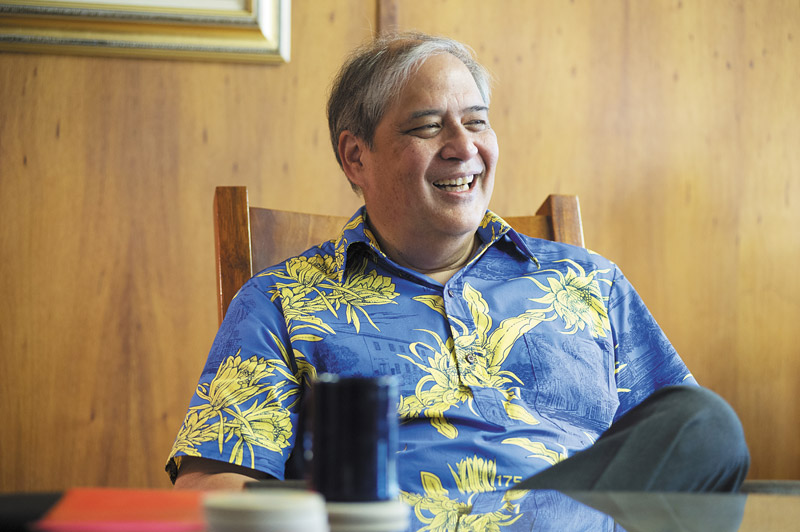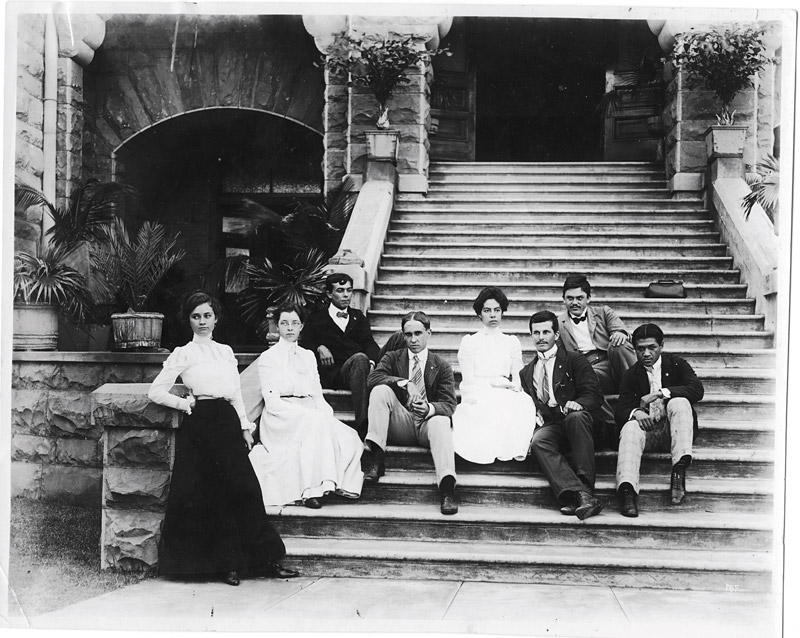Happy Demisemiseptcentennial, Punahou!
Yes, the Makiki school is celebrating it’s 175th anniversary, and school president James Scott is among the thousands looking forward to the Punahou Carnival next week — a crucial source of scholarship funds
Sure, Punahou School may be the largest single-campus private school in the country, the oldest school west of the Mississippi and boast such glittering alumni as President Barack Obama, U.S. Sen. Brian Schatz and AOL CEO Steve Case — all while fostering sports stars including Michelle Wie, Manti Te’o and Carissa Moore. But when it comes down to it, the school is all about family.
Its very beginnings center around keeping families together, as it was founded in 1841 by Congregationalist missionaries in response to the loss of their children. In those days, they had to ship their kids back to the East Coast to get an education, a six-month journey one way around the treacherous Cape Horn that often would mean not seeing their children again for decades, if ever.
Originally known as Oahu College, the campus opened its doors with just 15 students, but those were 15 fewer children who might never see their parents again.
On this, its demisemiseptcentennial, it now has more than 3,700 students in grades K-12, but the importance of ohana has not diminished. Generations in Hawaii have scrimped and saved to afford to send their kids to the Makiki campus, and its current president James Scott is one of those kids — Class of 1970.
He was raised in Waimanalo, and his father Buddy began saving for his Punahou tuition the day he was born, despite being unemployed at the time. His father was a Punahou grad and knew the importance of the experience for his boy.
The education he received served him well, got him into Stanford, but it was the ongoing relationships he created there that helped him when he began to stumble in his studies.
“My second year at Stanford I got cut from the baseball team,” says Scott, who wondered aloud if he should be sharing this story as the president of a school before continuing, “Every time I got a C in a class I would drop it, so I wasn’t even sure if I was a sophomore anymore. There was a war going on in Vietnam I could not support ethically, so I took a year off and came back to Punahou as an intern in the counseling department. After that year, I went back to school much more confident and disciplined.”
School is a stage in one’s life, but for Scott, Punahou is more than a stage, it is a family.
“I told the seniors the other day that it may be one of the coolest networks on earth, the Punahou alumni association,” says Scott, who has served as president since 1994. “Chances are that the Punahou alumni will be more of a network for them than their college, but also they will be touched personally and professionally by the association.”
Creating this kind of impact in a young person’s life should not be limited by finances, according to Scott. Currently, 15 percent of all Punahou students receive financial aid, though Scott is hoping to raise that number to 20 percent in the near future. He knows firsthand the struggle it can be to afford the best for your kids, and he wants to be able to offer the opportunities afforded by Punahou to the best and brightest in the Islands despite their economic standing.
“We are one of the most economically and ethnically diverse schools in America,” says Scott, who states that its average award is half tuition. “The financial aid money is driven by a vision that, if you are admitted to Punahou, we believe you have the talent and the promise to take advantage of all the resources here regardless of your financial circumstances. The operative measure is not the percentage of kids on financial aid, but are we being blind in our admissions, accept a class first, and then figure out how to get them in here.”
There are two ways it funds its financial aid: restricted endowments and the Punahou Carnival. The minutiae of how an endowment works may interest a few CPAs, but the carnival is the one we all know.
Since it first was held in 1932 and raked in a whop-ping $240, the annual event held the first weekend in February has grown into a state institution. Mouths water for the malasadas and mango chutney, screams fill Makiki from the rides, and hopes rise and fall with the toss of a ring or the bounce of a ball.
No less than 4,000 volunteers, including former students, parents and teachers, man the carnival, but it is organized by the junior class, which spends the year preparing for this two-day melee.
“It is not the top five of class leaders who put on the carnival,” says Scott. “It requires half to two-thirds of the class to step up, and that is pretty unique. I think it is the most ambitious student enterprise in America. If the weather is like this (indicating the beautiful Hawaii winter day out his window) they will gross $2 million in two days. It’s serious, it’s real work and it goes on all year long as far as the preparation and the planning.”
As it is Punahou’s 175th anniversary, the theme is “Rewind the Time” to look back at all the school has accomplished through the years and reach out to its farflung alumni.
“The celebration is not just an excuse to celebrate another milestone, but also to celebrate the journey and contributions of an extraordinary place,” says Scott, who plans to do a lot of traveling this year from Hong Kong to San Francisco to London, to gather alumni. “Half of our alums live away from Hawaii — we plan to use the anniversary to help put together alumni chapters.”
Having been president for 21 years now, to put it in perspective, there have been five University of Hawaii presidents during his tenure. He always has beaten the drum for the difference Punahou can make in young people. (Notably, he is the 16th Punahou president in 175 years, and just the third since 1944, having been preceded by John Fox and then Rod McPhee.)
“There is a lot of goodness here, a lot of promise. I feel like I can wake up every morning here and win,” says Scott, who received his doctorate in administration from Harvard. “It is rigorous in that it attracts hardworking people with high ideals — it can be strenuous in that regard.
“You want students to become self-directed learners, independent, confident, and you want them to have that built on extraordinary choices and opportunity. The college prep rigor, opportunities in academic electives, the arts, in athletics and the opportunity for leadership in things like carnival.”
He passes on this passion to his own children: Tessa, who is an outgoing senior, and Buddy, a sophomore. Even as the president’s kids, they do not always succeed in everything at the school, but Scott insists that is why options are so important.
“When my daughter was cut from the volleyball team, she started writing for the paper and she is the editor-in-chief right now,” says Scott. “That is the advantage of the scale and breadth of our programs.”
When citing the perks of having the job of top dog at Punahou, he of course lists the beautiful home on campus it provides, lots of free Punahou swag and a free education for the kids.
“It’s a good gig! It is a healthy place, it comes with a cool house and the best commute in Honolulu,” says Scott, who walks to work each day.
But just as in every family, Dad has to know when to step back.
“Our kids both are actively involved, and they enjoy school and are good at it, which is helpful. In talking to my colleagues around the country, it is pretty unusual if everyone is flourishing at the same time,” says Scott with a laugh.
“It is hard to be in your father’s school. I usually try to jump in the senior variety show, but I am not this year with my daughter Tessa being a senior. I need to just be a dad and not the president of the school, so that it is her show, not our show.
“So now I am in charge of bag checks at the show, checking for cell phones and cigarettes!”
PUNAHOU CARNIVAL
REWIND THE TIME: THE PUNAHOU JOURNEY
FRIDAY, FEB. 5, AND SATURDAY, FEB. 6 11 A.M. TO 11 P.M. EACH DAY
Admission to the grounds is free; scrips will be available for purchase throughout the carnival. Proceeds support the school’s financial aid program.
EVENTS/HIGHLIGHTS:
• Art Gallery (Opening Night Tuesday, Feb. 2, from 4:30 to 8 p.m., and open during Carnival Feb. 5 and 6, Mamiya Science Center) featuring more than 1,000 works of art created by more than 300 Hawaii artists, including paintings, photographs, wood bowls, ceramics, sculpture, jewelry, handbags and original fine art pieces.
• Silent Auction (Feb. 5 and 6 from 11 a.m. to 4 p.m., Mamiya Science Center, Cornuelle Lecture Hall)
• Booths and Rides – Enjoy a variety of E.K. Fernandez rides and about 60 food booths, including gyros, taco salad, corn on the cob, Portuguese bean soup, and, of course, the must-have carnival malasadas.
• White Elephant Tent (located at the Diamond Head end of carnival grounds) featuring a huge collection of secondhand goods for sale, including clothing, toys, books, music and more.








